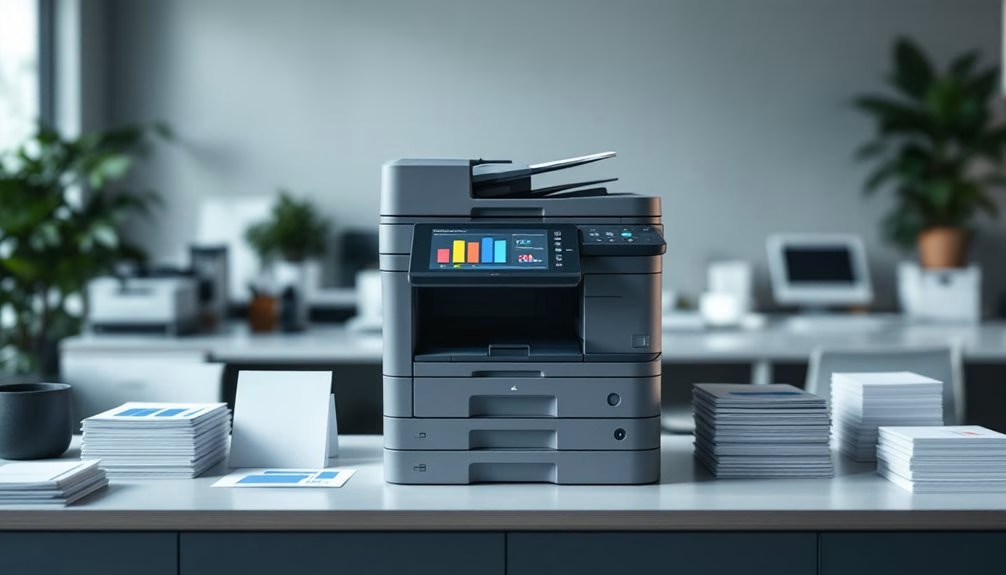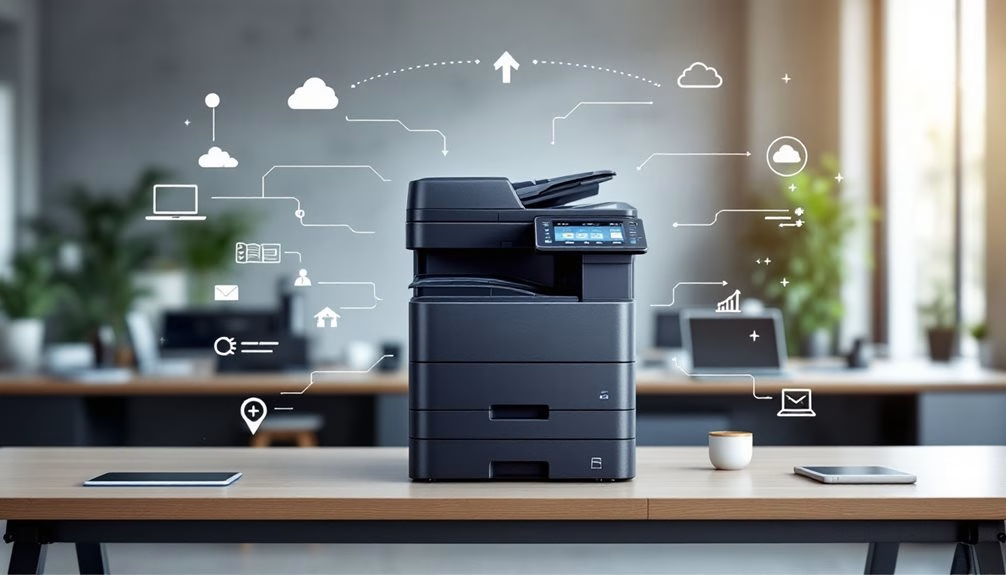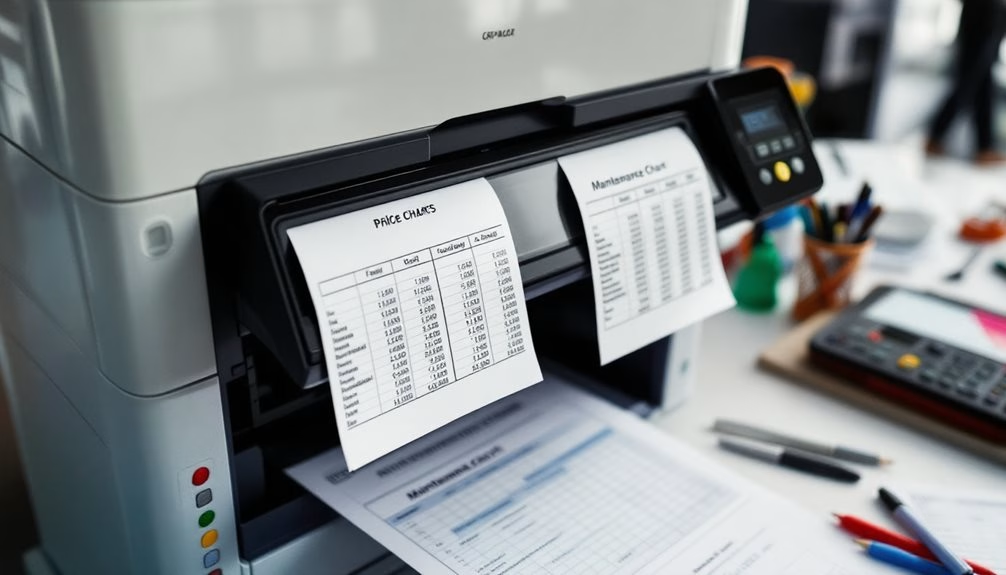We’ve all experienced the frustration of an office copier that doesn’t meet our needs – whether it’s constant paper jams, slow printing speeds, or confusing controls. Selecting the right copier involves more than just comparing prices and basic features. From evaluating daily printing requirements to reviewing security protocols, we’ll explore the key factors that guarantee your team gets a reliable workhorse instead of an expensive headache.
Expert Highlights
- Assess your team’s monthly print volume and specific requirements, including color printing needs and paper sizes commonly used.
- Verify essential features like cloud connectivity, mobile printing capabilities, and security measures to enhance workflow efficiency.
- Compare purchase versus lease options while factoring in maintenance costs, toner replacements, and total cost of ownership.
- Plan the copier’s physical placement to ensure adequate space, proper ventilation, and convenient access for all team members.
- Confirm network compatibility and security protocols, including user authentication and data encryption features.
Assessing Your Team’s Daily Print Volume and Requirements

Before selecting a copier for your office, you’ll need to carefully evaluate how much printing your team does on a typical day.
Let’s track your monthly print volume by counting sheets per employee, considering both single and double-sided prints.
We’ll also need to assess specific requirements like color printing, scanning capabilities, and paper sizes your team regularly uses.
Don’t forget to account for peak periods when your printing needs surge.
By understanding these patterns, we can choose a copier that meets your daily demands without overpaying for unnecessary features.
Remember to factor in any anticipated growth in your team’s printing needs.
Working with our sales consultants can help you navigate the many options available for your document workflow needs.
Essential Features and Technology Integration Options

When evaluating modern copiers, you’ll need to contemplate essential features that extend far beyond basic printing and scanning. Let’s explore the key technology integrations that’ll help our team work smarter.
| Feature | Benefit | Integration |
|---|---|---|
| Cloud Connectivity | Remote access to documents | Google Drive, Dropbox |
| Mobile Printing | Print from any device | AirPrint, PrinterOn |
| Security Features | Protected data & access | PIN codes, encryption |
| Workflow Apps | Automated processes | OCR, document routing |
We’ll want to guarantee our chosen copier supports email integration, document management systems, and network protocols that match our existing infrastructure. These features streamline our daily operations and keep us connected. Choosing the right equipment can boost team productivity with print speeds up to 60 PPM, significantly reducing workflow bottlenecks.
Cost Analysis: Purchase, Lease, and Long-Term Maintenance

Every business decision involving copiers requires careful financial consideration.
We’ll need to weigh the upfront costs of purchasing against the flexibility of leasing options. When buying, we’re looking at a significant initial investment but full ownership and potential tax benefits.
Leasing offers lower monthly payments and usually includes maintenance.
Let’s factor in long-term maintenance costs too. We should consider toner, paper, parts replacement, and service agreements.
Whether we purchase or lease, it’s smart to calculate our estimated monthly print volume and compare it with the total cost of ownership over the machine’s expected lifespan.
Operating leases provide short-term flexibility with lower monthly payments and are ideal for businesses wanting frequent technology updates.
Space Planning and Physical Placement Considerations

Proper placement and space planning for a copier can greatly impact office efficiency and workflow.
Strategic copier placement isn’t just about finding space – it’s about optimizing your entire office ecosystem for maximum productivity.
We’ll need to guarantee adequate clearance for paper loading, maintenance access, and user operation. Let’s consider placing the copier in a central location that’s easily accessible to team members while avoiding high-traffic areas that could create bottlenecks.
Before finalizing the location, we should check power outlet availability, ventilation requirements, and network connectivity options.
Don’t forget to account for noise levels – placing the copier too close to workstations can disrupt concentration.
We’ll also want to keep paper storage nearby for convenient restocking.
Our factory-trained technicians can provide guidance on optimal placement to ensure both accessibility and proper maintenance access for your multifunction device.
Security and Network Compatibility Standards

Since modern copiers connect to office networks, robust security features and network compatibility are essential considerations.
Let’s review the key standards we need to evaluate when selecting a networked copier for our team:
- User authentication protocols to control access and track usage, including PIN codes, ID cards, or biometric verification
- Data encryption capabilities for protecting sensitive information during transmission and storage
- Network protocol compatibility with our existing infrastructure, including wireless standards and security certificates
- Remote management features that enable IT teams to monitor security status and deploy updates across multiple devices
These security measures help safeguard our shared resources while maintaining efficient workflow.
Implementing advanced protection protocols can significantly strengthen security of sensitive documents while supporting comprehensive document management solutions.
Frequently Asked Questions
How Long Does It Take to Train Staff to Use a New Copier?
We’ll typically need 30-60 minutes to train our team on basic copier functions, though it can take a few days for everyone to feel comfortable with advanced features and troubleshooting.
What Happens if the Copier Breaks Down During a Critical Deadline?
We’ll need to contact service support immediately and have a backup plan ready. Most providers offer same-day repairs, but let’s also maintain relationships with local print shops for emergencies.
Can Different Departments Have Separate Access Codes for Billing Purposes?
We’ll help you set up unique access codes for each department, making it easy to track and bill copying expenses separately. Most modern copiers include this essential feature for budget management.
How Often Should We Schedule Preventive Maintenance for Optimal Performance?
We’ll want to schedule preventive maintenance every three months for high-volume usage or twice yearly for moderate use. Let’s make sure we’re following the manufacturer’s specific recommendations for our model.
What Backup Options Exist When the Main Copier Is Unavailable?
We’ll need reliable backup solutions like a secondary office copier, local print shops, mobile printing services, or networked printers. Let’s guarantee we’re never caught without printing capabilities when deadlines matter.
Expert Final Thoughts
We’ve explored the key factors in choosing the right copier for our team’s needs. From reviewing print volumes to evaluating security features, we recognize it’s essential to make an informed decision that aligns with our workflow. By carefully considering costs, space requirements, and technology integration, we’ll select a copier that enhances productivity while meeting our long-term business objectives.
About the Expert
Rafael M.
CEO of JR Copier
With over 35 years of hands-on experience in the copier and office printer industry, Rafael brings unparalleled expertise to every client interaction. His journey from service technician to CEO provides him with comprehensive understanding of all aspects of the business.
Areas of Expertise: Copier and printer sales, equipment leasing strategies, maintenance solutions, and managed print services. Rafael's deep industry knowledge ensures clients receive expert guidance, transparent pricing, and exceptional service for all their office equipment needs.
Connect on LinkedIn